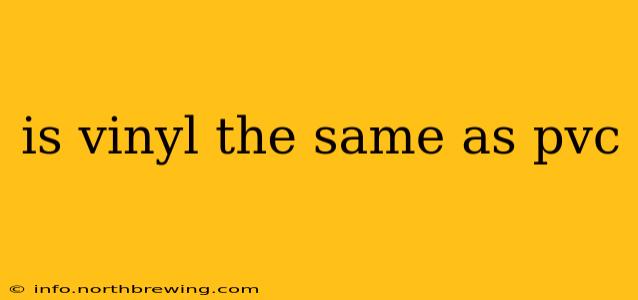The terms "vinyl" and "PVC" are often used interchangeably, leading to confusion. While closely related, they aren't precisely the same. This article clarifies the distinction and explores the properties and uses of both materials.
What is Vinyl?
"Vinyl" is a common, general term for a type of plastic that's flexible and durable. It encompasses a wide range of polymers used in various applications. Think of vinyl flooring, vinyl records, or vinyl siding – these all utilize vinyl polymers. The term often refers to the finished product rather than the specific chemical composition.
What is PVC?
PVC stands for polyvinyl chloride. This is a specific type of vinyl polymer. It's the most common type of vinyl plastic, making up a significant portion of the vinyl products we see daily. PVC is a versatile material known for its strength, durability, and resistance to chemicals and water.
Is PVC a type of vinyl, or is vinyl a type of PVC?
PVC is a type of vinyl. Vinyl is the broader category, encompassing various polymers, while PVC is a specific polymer within that category. Think of it like this: all squares are rectangles, but not all rectangles are squares. Similarly, all PVC is vinyl, but not all vinyl is PVC.
What are the different types of vinyl?
Besides PVC, other types of vinyl polymers exist, each with unique properties:
- Polyvinyl acetate (PVAc): Commonly used in adhesives, paints, and coatings.
- Polyvinylidene chloride (PVDC): Known for its exceptional barrier properties, often used in food packaging.
- Ethylene vinyl acetate (EVA): A flexible and impact-resistant copolymer used in footwear, adhesives, and other applications.
What are the properties of PVC?
PVC's popularity stems from its advantageous properties:
- Durability: Resists wear and tear, making it suitable for long-lasting products.
- Water resistance: Doesn't absorb water, making it ideal for outdoor applications.
- Chemical resistance: Withstands exposure to many chemicals and solvents.
- Cost-effectiveness: Relatively inexpensive to manufacture, contributing to its widespread use.
- Versatility: Can be molded into various shapes and forms.
What are the common uses of vinyl and PVC?
Both vinyl and PVC find applications in countless products:
- PVC: Pipes, flooring, window frames, siding, credit cards, medical devices.
- Other Vinyl Polymers: Adhesives, packaging, films, clothing, footwear.
What are the environmental concerns regarding PVC?
While PVC offers many benefits, some environmental concerns surround its production and disposal:
- Manufacturing process: Can involve the use of hazardous chemicals.
- Disposal: Not easily biodegradable and can persist in landfills for a long time.
- Incineration: Releases harmful dioxins if not handled properly.
Are there sustainable alternatives to PVC?
Yes, several more sustainable alternatives are emerging, including:
- Bioplastics: Made from renewable resources.
- Recycled PVC: Using recycled material reduces the demand for new PVC production.
- Other vinyl polymers with improved environmental profiles: Research and development continue to explore more eco-friendly options.
In conclusion, while often used interchangeably, vinyl and PVC are distinct but related materials. PVC is a specific type of vinyl polymer, renowned for its versatility and durability. However, understanding the broader context of different vinyl types and considering the environmental implications of PVC is crucial for informed material selection and responsible consumption.
